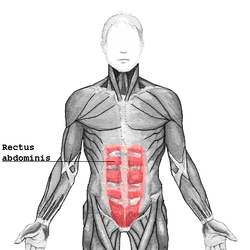Rectus abdominis
| Rectus abdominis | |
|---|---|

The human rectus abdominis muscle.
|
|
| Details | |
| Origin | Crest of pubis |
| Insertion | costal cartilages of ribs 5-7 Xiphoid process of sternum. |
| Artery | inferior epigastric artery |
| Nerve | segmentally by thoraco-abdominal nerves (T7 to T11) |
| Actions | Flexion of the lumbar spine |
| Antagonist | Erector spinae |
| Identifiers | |
| Latin | musculus rectus abdominis |
| TA | A04.5.01.001 |
| FMA | 9628 |
|
Anatomical terms of muscle
[]
|
|
The rectus abdominis muscle, also known as the "abdominals" or "abs", is a paired muscle running vertically on each side of the anterior wall of the human abdomen, as well as that of some other mammals. There are two parallel muscles, separated by a midline band of connective tissue called the linea alba. It extends from the pubic symphysis, pubic crest and pubic tubercle inferiorly, to the xiphoid process and costal cartilages of ribs V to VII superiorly. The proximal attachments are the pubic crest and the pubic symphysis. It attaches distally at the costal cartilages of ribs 5-7 and the xiphoid porcess of the sternum.
The rectus abdominis muscle is contained in the rectus sheath, which consists of the aponeuroses of the lateral abdominal muscles. Bands of connective tissue called the tendinous intersections traverse the rectus abdominus, which separates this parallel muscle into distinct muscle bellies. The outer, most lateral line, defining the "abs" is the linea semilunaris. In the abdomens of people with low body fat, these bellies can be viewed externally and are commonly referred to as "four", "six", "eight", or even "ten packs", depending on how many are visible; although six is the most common.
The rectus abdominis is a long flat muscle, which extends along the whole length of the front of the abdomen, and is separated from its fellow of the opposite side by the linea alba.
The upper portion, attached principally to the cartilage of the fifth rib, usually has some fibers of insertion into the anterior extremity of the rib itself.
It's typically around 10 mm thick (compared to 20 mm thick superficial fat), or 20 mm thick in young athletes such as handball players. Typical volume is around 300 cm³ in non-active individuals, or almost 500 cm³ in athletes (tennis players).
The rectus abdominis has many sources of arterial blood supply. In reconstructive surgery terms, it is a Mathes and Nahai Type III muscle with two dominant pedicles. First, the inferior epigastric artery and vein (or veins) run superiorly on the posterior surface of the rectus abdominis, enter the rectus fascia at the arcuate line, and serve the lower part of the muscle. Second, the superior epigastric artery, a terminal branch of the internal thoracic artery, supplies blood to the upper portion. Finally, numerous small segmental contributions come from the lower six intercostal arteries as well.
...
Wikipedia
